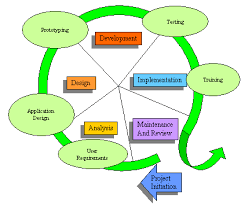
What Is Information Systems Analysis and Design? | PadaKuu.com
What Is Information Systems Analysis and Design?
<<
Direct and Indirect Measures, Reliability
What Is Information Systems Analysis and Design?
Information systems analysis and design is a method used by companies ranging from IBM to PepsiCo to Sony to create and maintain information systems that perform basic business functions such as keeping track of customer names and addresses, processing orders, and paying employees. The main goal of systems analysis and design is to improve organizational systems, typically through applying software that can help employees accomplish key business tasks more easily and efficiently. As a systems analyst, you will be at the center of developing this software.
The analysis and design of information systems are based on: Your understanding of the organization’s objectives, structure, and processes Your knowledge of how to exploit information technology for advantage To be successful in this endeavor, you should follow a structured approach. The SDLC, is a four-phased approach to identifying, analyzing, designing, and implementing an information system. we use the SDLC to organize our discussion of the systems development process. Before we talk about the SDLC, we first describe what is meant by systems analysis and design.
Systems Analysis and Design:Core Concepts
The major goal of systems analysis and design is to improve organizational systems. Often this process involves developing or acquiring application software and training employees to use it. Application software, also called a system,is designed to support a specific organizational function or process, such as inventory management, payroll, or market analysis. The goal of application software is to turn data into information.
For example, software developed for the inventory department at a bookstore may keep track of the number of books in stock of the latest best seller. Software for the payroll department may keep track of the changing pay rates of employees. A variety of off-the-shelf application software can be purchased, including WordPerfect, Excel, and PowerPoint. However, off-the-shelf software may not fit the needs of a particular organization, and so the organization must develop its own product.
In addition to application software, the information system includes:
- The hardware and systems software on which the application software runs. Note that the systems software helps the computer function, whereas the application software helps the user perform tasks such as writing a paper, preparing a spreadsheet, and linking to the Internet.
- Documentation and training materials, which are materials created by the systems analyst to help employees use the software they’ve helped create.
- The specific job roles associated with the overall system, such as the people who run the computers and keep the software operating.
- Controls, which are parts of the software written to help prevent fraud and theft.
- The people who use the software in order to do their jobs.
The components of a computer-based information system application are summarized in Figure 1-2. We address all the dimensions of the overall system, with particular emphasis on application software development—your primary responsibility as a systems analyst.
Our goal is to help you understand and follow the software engineering process that leads to the creation of information systems. As shown in Figure 1-3, proven methodologies, techniques, and tools are central to software engineering processes.
- Methodologies are a sequence of step-by-step approaches that help develop your final product: the information system. Most methodologies incorporate several development techniques, such as direct observations and interviews with users of the current system.
- Techniques are processes that you, as an analyst, will follow to help ensure that your work is well thought-out, complete, and comprehensible to others on your project team. Techniques provide support for a wide range of tasks, including conducting thorough interviews with current and future users of the information system to determine what your system should do, planning and managing the activities in a systems development project, diagramming how the system will function, and designing the reports, such as invoices, your system will generate for its users to perform their jobs.
- Tools are computer programs, such as computer-aided software engineering (CASE) tools, that make it easy to use specific techniques. These three elements— methodologies, techniques, and tools—work together to form an organizational approach to systems analysis and design.
FIGURE 1-3 The software engineering process uses proven methodologies, techniques, and tools.










